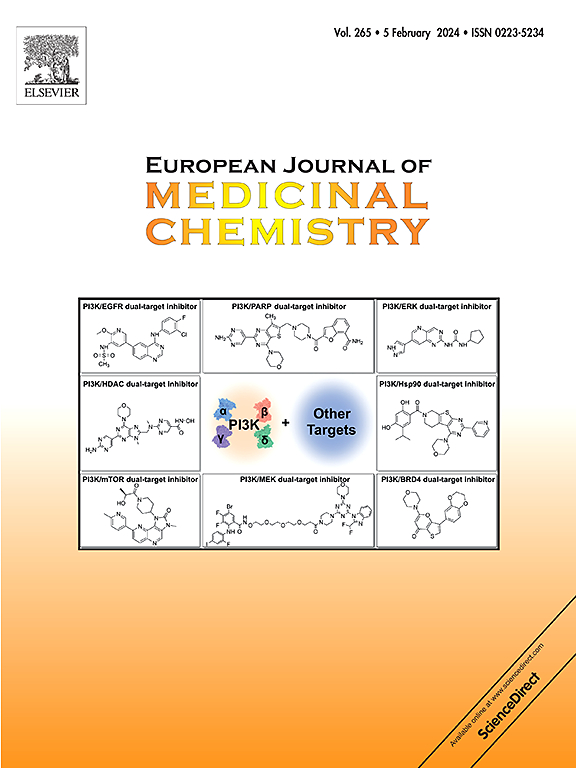N-(5-(2-morpholino-4-oxo-3,4-dihydroquinazolin-8-yl)pyridin-2-yl)acylamides as novel multi-PI3K/DNA-PK/P-gp inhibitors for efficient chemosensitization and MDR alleviation
IF 6
2区 医学
Q1 CHEMISTRY, MEDICINAL
引用次数: 0
Abstract
PI3K signaling pathway is crucial for a plethora of cellular processes and is extensively linked with tumorigenesis and chemo-/radioresistance. Although a number of small molecule inhibitors have been synthesized to control PI3K-mediated signaling, only a limited clinical success has been reached. Thus, the search for novel promising candidates is still ongoing. Herein, we present a novel series of N-(5-(2-morpholino-4-oxo-3,4-dihydroquinazolin-8-yl)pyridin-2-yl)acylamides designed to simultaneously inhibit PI3K and DNA-PK activity. Compared to a commercial DNA-PK/PI3K inhibitor AZD7648, synthesized compounds generally exhibited markedly lower baseline cytotoxicity in all tested cell lines (MC38, B16F10, 4T1, CT26 and HEK-239). Through an array of biological experiments, we selected two most promising compounds, 2 and 6. While in cell-free conditions, 6 acted as a very efficient pan-PI3K and DNA-PK inhibitor, in physiological conditions, 2 performed better and acted as a potent chemosensitizer able to increase the amount of DNA double strand breaks induced by doxorubicin. This was plausibly due to its improved ability to accumulate in nuclei as evidenced by confocal analyses. Importantly, using P-gp overexpressing CT26 cells, we found that 2 is an efficient inhibitor of multidrug resistance (MDR) able to down-regulate expression of mRNA encoding MDR-driving proteins ABCB1A, ABCB1B and ABCC1. We also demonstrate that 2 can be simply loaded into lipid nanoparticles that retain its chemosensitizing properties. Taken together, the presented study provides a solid basis for a subsequent rational structure optimization towards new generation of multitarget inhibitors able to control crucial signaling pathways involved in tumorigenesis and drug resistance.


N-(5-(2- morpholinos -4-oxo-3,4-二氢喹唑啉-8-基)吡啶-2-基)酰基酰胺作为新型多pi3k /DNA-PK/P-gp抑制剂的有效化学增敏和耐多药缓解
PI3K 信号通路对大量细胞过程至关重要,并与肿瘤发生和化疗/放射抗药性密切相关。虽然已经合成了许多小分子抑制剂来控制 PI3K 介导的信号转导,但临床上取得的成功有限。因此,寻找有前景的新型候选药物的工作仍在进行中。在此,我们提出了一系列新型的 N-(5-(2-吗啉基-4-氧代-3,4-二氢喹唑啉-8-基)吡啶-2-基)酰酰胺,旨在同时抑制 PI3K 和 DNA-PK 的活性。与商用 DNA-PK/PI3K 抑制剂 AZD7648 相比,合成的化合物在所有测试细胞系(MC38、B16F10、4T1、CT26 和 HEK-239)中普遍表现出明显较低的基线细胞毒性。通过一系列生物学实验,我们选出了两种最有前景的化合物,即 2 和 6。在无细胞条件下,6 是一种非常有效的泛 PI3K 和 DNA-PK 抑制剂;而在生理条件下,2 的表现更好,它是一种强效化疗增敏剂,能够增加多柔比星诱导的 DNA 双股断裂量。共聚焦分析表明,这可能是由于它在细胞核中的蓄积能力更强。重要的是,我们利用过表达 P-gp 的 CT26 细胞发现,2 是一种有效的多药耐药性(MDR)抑制剂,能够下调编码 MDR 驱动蛋白 ABCB1A、ABCB1B 和 ABCC1 的 mRNA 的表达。我们还证明,2 可以简单地装载到脂质纳米颗粒中,并保持其化疗增敏特性。综上所述,本研究为后续的合理结构优化奠定了坚实的基础,从而开发出新一代多靶点抑制剂,控制肿瘤发生和耐药性的关键信号通路。
本文章由计算机程序翻译,如有差异,请以英文原文为准。
求助全文
约1分钟内获得全文
求助全文
来源期刊
CiteScore
11.70
自引率
9.00%
发文量
863
审稿时长
29 days
期刊介绍:
The European Journal of Medicinal Chemistry is a global journal that publishes studies on all aspects of medicinal chemistry. It provides a medium for publication of original papers and also welcomes critical review papers.
A typical paper would report on the organic synthesis, characterization and pharmacological evaluation of compounds. Other topics of interest are drug design, QSAR, molecular modeling, drug-receptor interactions, molecular aspects of drug metabolism, prodrug synthesis and drug targeting. The journal expects manuscripts to present the rational for a study, provide insight into the design of compounds or understanding of mechanism, or clarify the targets.

 求助内容:
求助内容: 应助结果提醒方式:
应助结果提醒方式:


